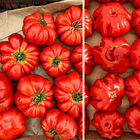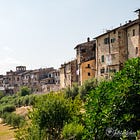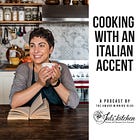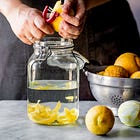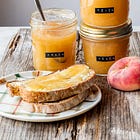Summer cooking and a recipe for peperonata
The Southern Italian sweet and sour pepper stew that will keep giving for many meals.
This newsletter is a reader-supported publication. We’re trying to keep things as free as possible, but if you enjoy what I write and want access to exclusive weekly recipes, and if you are at a point in your life to support our newsletter, please consider becoming a paid subscriber. Thank you!
Summer cooking happens in a dark, silent kitchen.
Dark because it often happens in the afternoon when all the shutters are closed to keep the summer heat at bay. I turn on just the counter led light, self-convinced that a dark kitchen is a cooler kitchen. Silent, because usually, Livia is asleep in her bedroom, sprawled in her bed among books and dolls. Out of my kitchen come just muffled sounds: I move cautiously around the kitchen table, putting the glass bowl on the marble countertop in slow motion.
Summer cooking is private, personal. It is cooking on my own terms. I cook barefoot, with shorts and an oversized white T-shirt. A faded, splattered apron is hopelessly trying to keep it clean. While I cook, I nibble on cold, ripe plums from the fridge, and drink room-temperature water with a squeeze of lemon.
Vegetables are crammed on the counter, a rough plot of what is going to happen. In the morning, I gathered a bunch of fresh herbs from the garden—basil, mint, sage, and a few sprigs of thyme—and put them in a bowl of cold water, ready for the action to begin. I won’t need many tools: a couple of wooden spoons, a heavy cutting board, a chef knife and a pairing knife, and some battered pans.
Even though I love autumn and winter—the cozy atmosphere, sleeping under a duvet, brisk morning walks, a hot tea in the afternoon— I have a love affair with summer and its produce.
Summer cooking revolves around seasonal vegetables: tomatoes, zucchini, bell peppers, green beans, eggplants, all paired with pantry staples—anchovies, breadcrumbs, olives, oregano, dry pasta or rice, plenty of extra virgin olive oil—and some cheese. Everything else is accessory.
Sometimes it’s just a tomato tonnato, sometimes it’s a green bean and potato salad with boiled eggs and tuna.
Sometimes, summer cooking involves a hot oven. I’m not scared of the furnace temperatures I’ll create in my kitchen: roasted peppers and tomatoes, a summer quiche with ricotta and zucchini blossoms, or even a yogurt cake topped with poached stone fruit, they are all worth the hassle.
The same can be said for long, slow stews: how can you resist the call of a tomato sauce when tomatoes are so ripe and abundant? How can you ignore those bell peppers, begging to be turned into a peperonata, the Italian sweet and sour pepper stew?
A bit of time management and organization, that’s what I need. I’ll prep all the vegetables, turn on the oven, put on a stew, then I’ll leave the dishes to cook unassisted while I’ll seek refuge in another room with a book or—in worst scenarios, with my laptop to answer a couple of emails.
Come dinner time, you’ll forget the hot oven and the damp air. What is left is just the joy of homemade food, cooked on my own term. It’s like a Giulia from the past is taking care of me now, perfectly aware of how tiring a summer day can be.
Where are our vegetables coming from?
I wished I could say from our own vegetable garden, but, alas, it is not producing enough vegetables to cover all our requests and the needs of cooking classes. Lettuce, cucumbers, sometimes tomatoes and eggplants, and sweet green peppers are usually homegrown, but when we need bigger quantities or more varieties, we either shop at the local market, which is held every Wednesday morning, or at Azienda Agricola Sant’Ulivieri, a local farm we just started working with. (YES, they are also a beautiful agriturismo where you can stay, with a postcard-like view over San Gimignano, in the quiet of the countryside).
It’s a 20-minute drive to get to the farm, and located between Colle Val D'Elsa and San Gimignano: you can shop directly at their farm, or you can find their best seasonal produce in their shop in Colle Val D'Elsa (the one also listed also in our food guide). Along with their fruit and vegetables, here you can also purchase their beans, chickpeas and lentils, their extra virgin olive oil, wine, preserves and jams, cooked vegetables, local biodynamic cheese, the outstanding bread and focaccia from Forno Pellegrino, and artisanal pasta.
You can also follow them on Instagram.
I love their Florentine ribbed tomatoes, the huge, sweet, crisp watermelons, and their zucchini flowers, to be stuffed with ricotta, a piece of anchovy, and a single basil leaf.
TIME MACHINE - If you missed them, there are more interesting recipes from the archive
RECIPE - Peperonata
August and September are the months when the sweet bell peppers are at their best. This is also when I make peperonata, during the afternoons I spend cooking barefoot in my kitchen, or during my cooking classes.
Peperonata is a Southern Italian sweet and sour pepper stew that will keep giving for many meals. As with many Italian stew recipes, this is one of those dishes that is better eaten the day after. So long live leftovers.
Even though Italians are often concerned about their digestion, and peperonata is undisputedly considered one of the heaviest dishes of our culinary tradition, in my family we have never been worried about these digestive issues. The fact that peppers are one of the only vegetables my mum would gladly eat certainly helps.




